
Naval Air Warfare Center Weapons Division Archive Center |
The Naval Air Warfare Center Weapons Division Archive Center located at the Naval Base Ventura County, Point Mugu is home to a large collection of air-to-air and air-to-surface missiles and electronics countermeasures equipment. It is open to the public from 10:00 AM to 3:00 PM each Wednesday. It is located in Building 112, just outside the main gate.
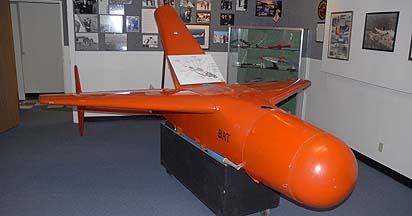 ASM-N-2 Bat radar-guided glide bomb was originally carried by
Consolidated PB4Y-2 Privateers. It carries an active S-band radar
transmitter to track the target, allowing the launch plane to
take evasive action after launch.
ASM-N-2 Bat radar-guided glide bomb was originally carried by
Consolidated PB4Y-2 Privateers. It carries an active S-band radar
transmitter to track the target, allowing the launch plane to
take evasive action after launch.
There is another Bat Missile at the National Institute of Standards and Technology Museum in Gaithersburg, Maryland.
The National Air & Space Museum also has a Bat.
More information about the Bat Glide Bomb is available on Bathead's web site.
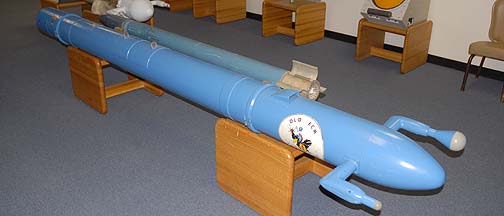 The DLQ-3 is an electronic countermeasures threat simulation pod.
The DLQ-3 is an electronic countermeasures threat simulation pod.
Federation of American Scientists page about the ALQ-167.
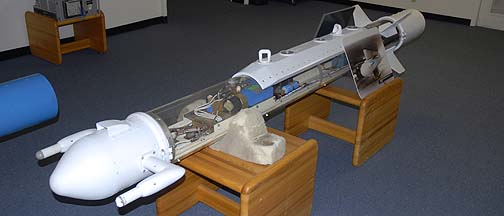 This ALQ-167 electronic warfare training aid has a plexiglas housing to permit viewing of the internal electronic components.
This ALQ-167 electronic warfare training aid has a plexiglas housing to permit viewing of the internal electronic components.
 The AGM-53 Condor was a rocket-powered TV-guided missile developed in the 1970s.
The AGM-53 Condor was a rocket-powered TV-guided missile developed in the 1970s.
GlobalSecurity.org's page about the AGM-53 Condor.
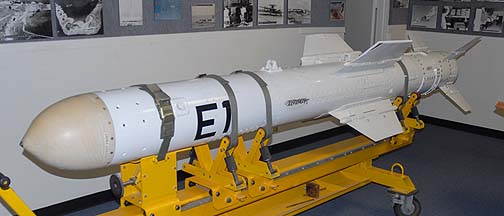 AGM-84 Harpoon anti-shipping missile uses inertial navigation to approach its target. Once near the target it uses radar to acquire and attack the target. It has a range of over 60 miles.
AGM-84 Harpoon anti-shipping missile uses inertial navigation to approach its target. Once near the target it uses radar to acquire and attack the target. It has a range of over 60 miles.
Navy Fact File about the AGM-84 Harpoon.
PMA205 Naval Aviation Training Systems page about the AGM-84 Harpoon.
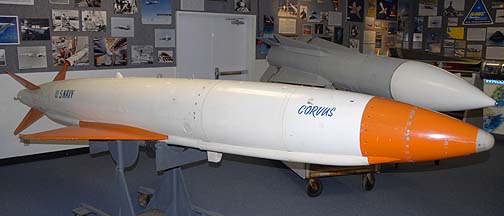 XASM-N-8 Corvus was a supersonic radar-guided air-to-surface missile developed in the late 1950s.
XASM-N-8 Corvus was a supersonic radar-guided air-to-surface missile developed in the late 1950s.
Vought Aircraft page about the XASM-N-8 Corvus.
 AIM-54 Phoenix long range,
active, radar-guided air-to-air missile carries its own radar transmitter for tracking its target. It has a range of over 100 miles and flies faster than a Lockheed SR-71A Blackbird.
AIM-54 Phoenix long range,
active, radar-guided air-to-air missile carries its own radar transmitter for tracking its target. It has a range of over 100 miles and flies faster than a Lockheed SR-71A Blackbird.
Federation of American Scientists page about the AIM-54 Phoenix.
Raytheon's page about the AIM-54 Phoenix.
Navy Fact File about the AIM-54 Phoenix.
.
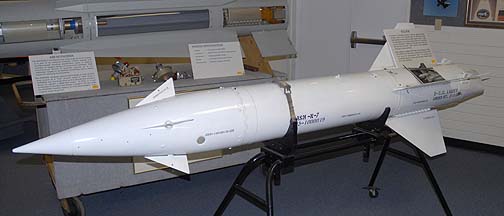 AGM-12 Bullpup radio-guided air-to-ground missile.
AGM-12 Bullpup radio-guided air-to-ground missile.
The AGM-12 Bullpup was equipped with flares to allow the pilot of the attacking airplane to track it visually. The pilot had to follow the missile directly toward the target, feeding it course corrections by radio, until it impacted.
Federation of American Scientists page about the AGM-12 Bullpup.
Directory of U. S. Military Rockets and Missiles page about the AGM-12 Bullpup.
 AGM-65F Infra-red Maverick is a fire-and-forget missile, tracking
the target independently after launch.
AGM-65F Infra-red Maverick is a fire-and-forget missile, tracking
the target independently after launch.
Federation of American Scientists page about the AGM-65 Maverick.
Air Force Fact Sheet about the AGM-65 Maverick.
Navy Fact File about the AGM-65 Maverick.
PMA205 Naval Aviation Training Systems page about the AGM-65 Maverick.
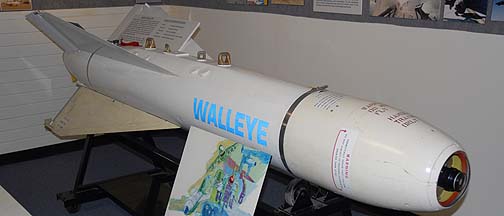 AGM-62 Walleye II television-guided, glide bomb tracks on a video image of the target. While very accurate against high contrast targets, the television guidance system has difficulty with low contrast targets.
AGM-62 Walleye II television-guided, glide bomb tracks on a video image of the target. While very accurate against high contrast targets, the television guidance system has difficulty with low contrast targets.
Directory of U. S. Military Rockets and Missiles page about the AGM-62 Walleye.
Federation of American Scientists page about the AGM-62 Walleye.
PMA205 Naval Aviation Training Systems page about the AGM-62 Walleye.
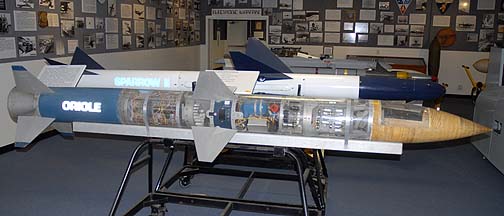 The AAM-N-4 Oriole was an unsuccessful attempt to develop an active radar-guided air-to-air missile in 1947. In the 1950s, the Oriole served as a missile testbed.
The AAM-N-4 Oriole was an unsuccessful attempt to develop an active radar-guided air-to-air missile in 1947. In the 1950s, the Oriole served as a missile testbed.
 The AIM-7 Sparrow was the first in a line of medium-range, radar-guided, air-to-air missiles.
The AIM-7 Sparrow was the first in a line of medium-range, radar-guided, air-to-air missiles.
 Sparrow-IR was a Sparrow missile with the infra-red seeker head of the AIM-9 Sidewinder.
Sparrow-IR was a Sparrow missile with the infra-red seeker head of the AIM-9 Sidewinder.
Federation of American Scientists page about the AIM-7 Sparrow.
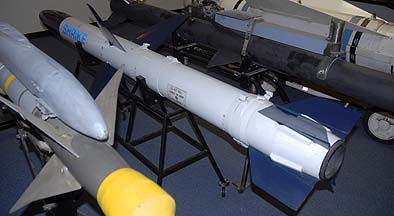 AGM-45 Shrike anti-radar missiles were carried by Republic F-105G Wild Weasels, McDonnell-Douglas F-4G Wild Weasels, Grumman EA-6A Prowlers, and Vought A-7 Corsairs. The AGM-45 Shrike was based on the Sparrow radar-guided, air-to-air missile. If the targeted enemy radar shut down, it was unable to continue tracking the target.
AGM-45 Shrike anti-radar missiles were carried by Republic F-105G Wild Weasels, McDonnell-Douglas F-4G Wild Weasels, Grumman EA-6A Prowlers, and Vought A-7 Corsairs. The AGM-45 Shrike was based on the Sparrow radar-guided, air-to-air missile. If the targeted enemy radar shut down, it was unable to continue tracking the target.
Federation of American Scientists page about the AGM-45 Shrike.
Directory of U. S. Military Rockets and Missiles page about the AGM-45.
 AIM-120 Advanced Medium Range Air-to-Air Missile (AMRAAM) is a follow-on to the AIM-7 Sparrow. It carries a radar transmitter to illuminate the target, so that the launching fighter can turn away from the target after launch.
AIM-120 Advanced Medium Range Air-to-Air Missile (AMRAAM) is a follow-on to the AIM-7 Sparrow. It carries a radar transmitter to illuminate the target, so that the launching fighter can turn away from the target after launch.
Federation of American Scientists page about the AIM-120 AMRAAM.
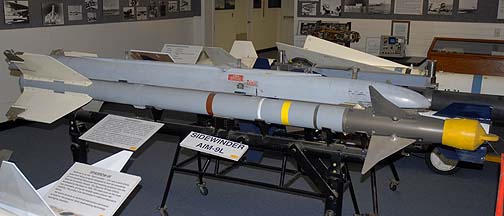 The infra-red guided AIM-9 Sidewinder was developed fifty years ago by the Naval Ordnance Test Station at Naval Air Weapons Station China Lake. Sidewinders are used at relatively short range.
The infra-red guided AIM-9 Sidewinder was developed fifty years ago by the Naval Ordnance Test Station at Naval Air Weapons Station China Lake. Sidewinders are used at relatively short range.
U. S. Navy Fact File for the AIM-9 Sidewinder.
Federation of American Scientists page about the AIM-9 Sidewinder.
Raytheon's page about the AIM-9 Sidewinder.
Directory of U. S. Military Rockets and Missiles page about the AIM-9 Sidewinder.
 NV-105A subsonic target drone was produced as the MQM-74A Chukar.
NV-105A subsonic target drone was produced as the MQM-74A Chukar.
Wikipedia entry about the BQM-74 Chukar.
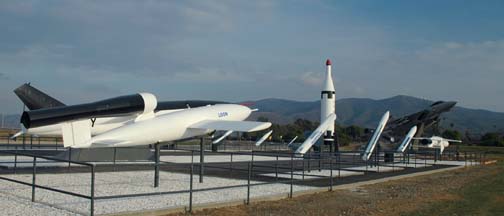 The Point Mugu Naval Air Station is home to the Pt. Mugu Missile Park. There
you can see a wide variety of the missiles and airplanes that have been tested at Point Mugu since World War II.
The Point Mugu Naval Air Station is home to the Pt. Mugu Missile Park. There
you can see a wide variety of the missiles and airplanes that have been tested at Point Mugu since World War II.
 China Lake NAWS is home to the U.S. Naval Museum of Armament & Technology. It houses an extensive collection of missiles and weapons delivery systems.
China Lake NAWS is home to the U.S. Naval Museum of Armament & Technology. It houses an extensive collection of missiles and weapons delivery systems.
Send a message to Brian.